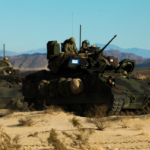
The Trump Administration on Dec. 18 released an America First national security strategy that promotes domestic economic growth as fuel for beefing up the military, modernizing its weapons and projecting might abroad.Instead of isolating the United States, the document calls for a policy of “peace through strength” in which the United States does not shrink from its global responsibilities, engages from a position of power. Both diplomatically and militarily, the U.S. will prioritize its own interests without abandoning allies who…

 By
By 











